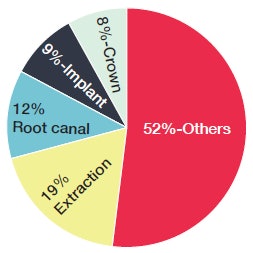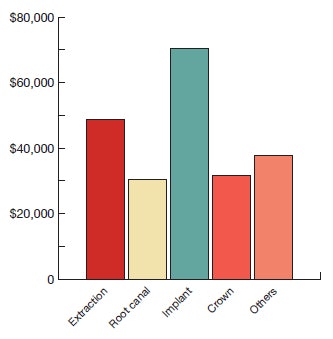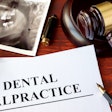
This article is reprinted with permission from the American Student Dental Association. It originally appeared in the summer 2013 issue of Mouth.

In a profession fueled by referrals and word-of-mouth marketing, public perception is key. A malpractice suit can tarnish a dentist's reputation. It is also a financial burden, with lost settlement money, attorney fees, and productivity. According to Medical Protective, an American Student Dental Association (ASDA) sponsor and the country's oldest malpractice insurance company, dentists are usually sued once in their career. The average payment to a plaintiff in a dental malpractice lawsuit is $65,000.
Many malpractice suits have one thing in common: a claim of violation of appropriate standards of care. The ADA Principles of Ethics and Code of Professional Conduct states that ADA member dentists are expected to "possess not only knowledge, skill, and technical competence but also those traits of character that foster adherence to ethical principles. Qualities of honesty, compassion, kindness, integrity, fairness, and charity are part of the ethical education of a dentist and practice of dentistry and help to define the true professional."
In dentistry, standards of care vary from state to state and are not written documents or sets of rules. While specific standards of care may vary by state, the legal definition of the standard of care in dentistry remains the same across the U.S. It is defined as follows: "what a reasonable and prudent dentist would do under the same or similar circumstances." The standard of care is often defined in a courtroom by expert testimony.
Extractions
According to Medical Protective, between 2003 and 2012, nearly 20% of dental malpractice cases involved the extraction of teeth. The average compensation from an extraction malpractice case was $48,600. Extractions can lead to many complications, including nerve damage, osteoradionecrosis, and jaw fracture. If the standard of care is violated, signed consent forms will not always protect a dentist from a malpractice suit. However, written consent forms can help protect you from a successful lawsuit if informed consent is part of the complaint against you.
 Dental malpractice claims from 2003-2012. Source: Medical Protective.
Dental malpractice claims from 2003-2012. Source: Medical Protective.
Medical Protective's September 2012 Malpractice Minute highlights a case of extraction resulting in nerve damage. A preoperative radiograph was taken of tooth No. 32. This radiograph did not show the entire apex of the tooth, which had an unexpectedly bulbous root. The dentist proceeded with the procedure, expecting a routine extraction. When the dentist experienced difficulty extracting the tooth, another radiograph revealed the root's unique apex. After sectioning the tooth, it was delivered without complication. Two weeks later, the patient reported lingering numbness from the procedure. An oral surgeon confirmed the lingual nerve damage, and a suit was filed against the original dentist.
In this case, inadequate radiographs led to lasting consequences for both the dentist and patient. The case illustrates the importance of diagnosing and planning to avoid complications.
Endodontics
Endodontic procedures accounted for 12% of dental malpractice suits between 2003 and 2012. According to Medical Protective, root canal malpractice cases average in compensations of $30,300.
 Average indemnity by allegation. Source: Medical Protective.
Average indemnity by allegation. Source: Medical Protective.
The February 2013 Malpractice Minute featured the case of a 20-year-old patient and a dentist with two years of experience. The patient complained of pain in a mandibular first molar, and the dentist diagnosed periapical pathology indicating root canal treatment. Using a rubber dam for isolation, the dentist began the procedure. The working lengths were confirmed during the procedure with four periapical radiographs. The canals were easily obturated, so the dentist decided to forgo a postoperative radiograph. The patient returned two days later with lingering numbness. A new radiograph revealed root canal sealer leaked into the mandibular canal. After six months with no improvement, microsurgery restored some, but not all, of the patient's feeling.
This complication could have been avoided by carefully evaluating the risk of the procedure before beginning. When a patient's anatomy or age places them in a high-risk category, dentists should evaluate their comfort level and refer if necessary. For high-risk procedures, informed consent is crucial.
Crowns
According to Medical Protective, crown malpractice cases result in an average compensation of $31,600 and account for 8% of all dental malpractice cases. ABC News reported on February 16 that country music star LeAnn Rimes sued her dentist for the placement of eight crowns resulting in chronic gum inflammation, bleeding, and pain for two years. She claimed the pain prevented performances, so she is also suing for loss of income. The crowns were replaced and allegedly caused the need for nine root canals and an extraction. ABC News reached out to the dentist to hear his side but didn't receive a comment. Regardless, his reputation has suffered.
Mario Catalano, DDS, serves as a dental consultant to Medical Protective and has reviewed more than 850 malpractice cases during the past 25 years. He is also a frequent presenter at ASDA national events, sharing stories to educate dental students. According to Dr. Catalano, "the single best way to avoid a lawsuit is to always put the patient's best interest first. In many malpractice actions, there is a true disconnect between what the patient wants or needs and what the dentist has delivered."
Dr. Catalano urges new dentists to develop treatment and examination protocols early in their careers. For example, he suggests greeting patients with "How may I help you?" to immediately begin your relationship with a new patient on a positive, nurturing note. In his experience, new dentists may have a slightly higher incidence of malpractice suits for two reasons: "[They] lack the skill or experience to avoid certain situations, or the ability to rectify problems is removed from them by employers."
Practicing within the standard of care is non-negotiable. Dentists make mistakes, but those mistakes must be recorded and explained in detail to the patient. Careful documentation of patient records, thoroughly informed patients, and an excellent doctor-patient relationship can help a dentist avoid the courtroom.
Megan Guthman is a contributing editor for the American Student Dental Association and a dental student at the University of Alabama at Birmingham School of Dentistry.
Note: The above article has been edited from its original version following review by Thomas J. David, DDS.



















